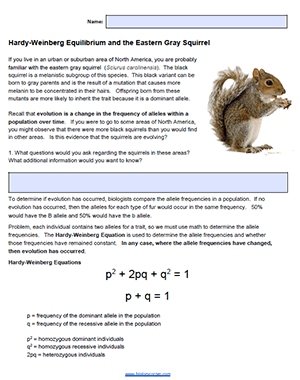
This activity was created for students to complete on their own during the Covid-19 pandemic. Hardy Weinberg equilibrium can be a difficult concept, even with class guidance, so I’ve attempted to break it down into small bite-sized pieces.
The Hardy-Weinberg equation is a fundamental principle in population genetics that describes the relationship between allele frequencies and genotype frequencies in a population that is not evolving. It is often used to study genetic variation and to determine whether a population is evolving or in genetic equilibrium.
The activity starts with a description of North American squirrels, which are mostly gray in color. Black squirrels can be found in some areas. Students use the Hardy Weinberg equation to determine the frequency of black squirrels (black is a dominant allele) and use the results to determine if the populations show evidence that evolution has occurred.
A khan academy video is embedded in the lesson to explain how to uses the equation. If we were in class, I would probably explain it and show examples, but the video does makes it fairly simple for students to try to get it on their own.
The last section of the activity requires students to use a deck of cards to see if the HW equation can accurately predict the frequency of red and black cards in the deck. Students draw twenty cards at random, with black representing the dominant (B) allele and red representing the recessive (b) gray allele.
After drawing 20 cards, they can use the equation to see if they get close to a 50/50 ratio on black and red alleles. If students don’t have a deck of cards they are advised they can use other types of cards, or even use an online card simulator.

Students can also do the Hardy Weinberg Problemset, but at this point, I’m not sure I’ll require it for my students during this time.
The Squirrel activity is meant to just give them a basic introduction to the Hardy Weinberg equilibrium and the opportunity to work with the equation.

